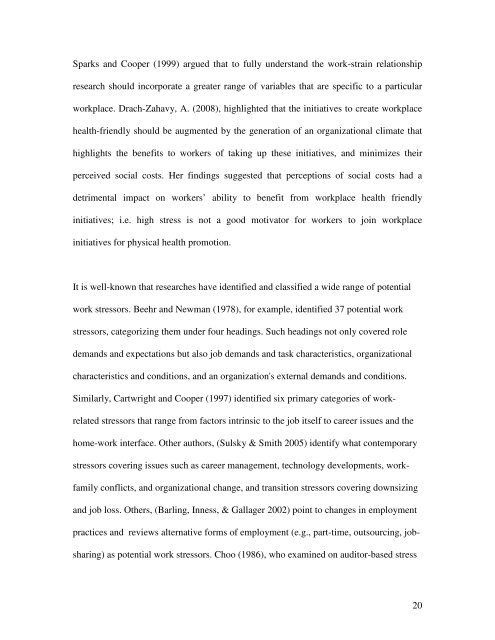1 CHAPTER 1 INTRODUCTION 1.0 Overview Over ... - DSpace@UM
1 CHAPTER 1 INTRODUCTION 1.0 Overview Over ... - DSpace@UM
1 CHAPTER 1 INTRODUCTION 1.0 Overview Over ... - DSpace@UM
Create successful ePaper yourself
Turn your PDF publications into a flip-book with our unique Google optimized e-Paper software.
Sparks and Cooper (1999) argued that to fully understand the work-strain relationshipresearch should incorporate a greater range of variables that are specific to a particularworkplace. Drach-Zahavy, A. (2008), highlighted that the initiatives to create workplacehealth-friendly should be augmented by the generation of an organizational climate thathighlights the benefits to workers of taking up these initiatives, and minimizes theirperceived social costs. Her findings suggested that perceptions of social costs had adetrimental impact on workers’ ability to benefit from workplace health friendlyinitiatives; i.e. high stress is not a good motivator for workers to join workplaceinitiatives for physical health promotion.It is well-known that researches have identified and classified a wide range of potentialwork stressors. Beehr and Newman (1978), for example, identified 37 potential workstressors, categorizing them under four headings. Such headings not only covered roledemands and expectations but also job demands and task characteristics, organizationalcharacteristics and conditions, and an organization's external demands and conditions.Similarly, Cartwright and Cooper (1997) identified six primary categories of workrelatedstressors that range from factors intrinsic to the job itself to career issues and thehome-work interface. Other authors, (Sulsky & Smith 2005) identify what contemporarystressors covering issues such as career management, technology developments, workfamilyconflicts, and organizational change, and transition stressors covering downsizingand job loss. Others, (Barling, Inness, & Gallager 2002) point to changes in employmentpractices and reviews alternative forms of employment (e.g., part-time, outsourcing, jobsharing)as potential work stressors. Choo (1986), who examined on auditor-based stress20
















